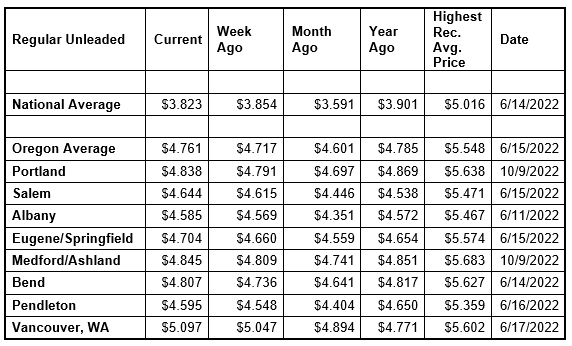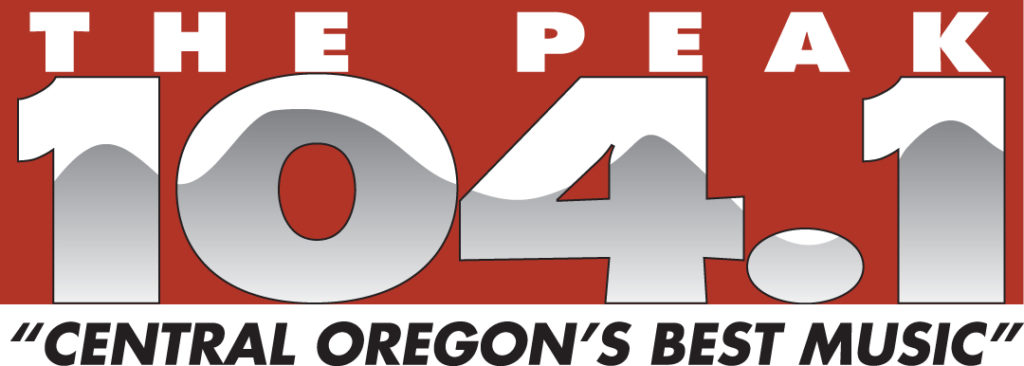Gas prices are showing minimal movement this week, leading up to the Labor Day holiday. Oregon is one of 48 states where prices have changed by less than a dime. Slightly lower crude oil prices have helped slow increases at the pumps. However, as Labor Day approaches, pump prices could move up again due to increasing demand for gas and an active hurricane season. For the week, the national average dips three cents to $3.82. The Oregon average climbs four cents to $4.76.

Demand for gas is likely to increase leading up to Labor Day. AAA booking data for flights, hotels, rental cars and cruises shows Labor Day travel is up compared to last year. Domestic bookings are up 4% and international bookings are up 44%. Find all the details in the AAA Labor Day travel news release.
“Storms have the potential to disrupt production, especially in the Gulf Coast region where more than 47% of total U.S. petroleum refining capacity is located,” says Marie Dodds, public affairs director for AAA Oregon/Idaho. “Extreme heat can also lead to reduced output at refineries, as we’ve seen this summer.”
Gas prices for the Labor Day holiday weekend will be lower than last year when drivers paid the highest gas prices ever for the holiday.

Gas prices normally come down in mid-September when the transition to winter-blend fuel begins. It is cheaper to produce than summer-blend fuel, which helps reduce emissions from gasoline during the warm summer months. More info on summer- and winter-blend gasoline can be found at the EPA website.
Crude oil prices have simmered down after rallying for seven weeks in a row. Crude prices dropped below $80 per barrel last week but have nudged past the $80 mark to start this week. The highest price in the last month was about $84 on August 9. The higher crude prices were driven in part by Saudi Arabia’s extension of its production cuts of one million barrels a day through September.
Crude oil is trading around $80 today compared to $80 a week ago and $97 a year ago. In July, West Texas Intermediate ranged between about $69 and $82 per barrel. In June, WTI ranged between about $67 and $73 per barrel. In May, WTI ranged between about $63 and $77 per barrel. In April, WTI ranged between about $73 and $83. In March, WTI ranged between about $64 and $81 per barrel. In February, WTI ranged between about $73 and $80 per barrel. In January, WTI ranged between about $73 and $82 bbl. Crude reached recent highs of $123.70 on March 8, 2022, shortly after the Russian invasion of Ukraine, and $122.11 per barrel on June 8, 2022. The all-time high for WTI crude oil is $147.27 in July 2008.
Crude oil is the main ingredient in gasoline and diesel, so pump prices are impacted by crude prices on the global markets. On average, about 50% of what we pay for in a gallon of gasoline is for the price of crude oil, 25% is refining, 11% distribution and marketing, and 14% are taxes, according to the U.S. Energy Information Administration.
Demand for gasoline rose from 8.85 million b/d to 8.91 million b/d for the week ending August 18, according to the U.S. Energy Information Administration (EIA). This compares to 8.43 million b/d a year ago. Meanwhile, total domestic gasoline stocks increased from 216.2 million bbl to 217.6 million bbl. Although stocks have increased, greater demand over the Labor Day holiday, the impact of weather, and fluctuating oil prices are likely to keep pump prices elevated.
Quick stats
Oregon is one of only eight states with higher prices now than a week ago. Arizona (+10 cents) has the largest weekly jump. Indiana (-13 cents) has the biggest weekly decrease.
California ($5.29) has the most expensive gas in the nation for the fifth week in a row. Washington ($5.10) is second. These are the only two states with averages at or above $5 a gallon. Hawaii ($4.78) is third, Oregon ($4.76) is fourth, Alaska ($4.60) is fifth, Nevada ($4.50) is sixth, Arizona ($4.33) is seventh, Utah ($4.28) is eighth, Idaho ($4.15) is ninth, and Illinois ($4.08) is 10th. These are the 10 states with averages at or above $4 a gallon, down from 11 states and D.C. a week ago. This week 40 states and the District of Columbia have averages in the $3-range. No state has an average in the $2 range this week.
The cheapest gas in the nation is in Mississippi ($3.29) and Louisiana ($3.93). For the 137th week in a row, no state has an average below $2 a gallon.
The difference between the most expensive and least expensive states is almost $2.00 this week, compared to $1.95 a week ago.
Oregon is one of 44 states and the District of Columbia with higher prices now than a month ago. The national average is eight cents more and the Oregon average is 16 cents more than a month ago. This is the eighth-largest monthly increase in the nation. Arizona (+51 cents) has the largest monthly jump. South Carolina (-7 cents) has the smallest.
Oregon is one of 36 states and the District of Columbia with lower prices now than a year ago. The national average is three cents less and the Oregon average is two cents less than a year ago. Hawaii (-53 cents) has the largest yearly drop. Washington (+36 cents) has the largest year-over-year increase.






